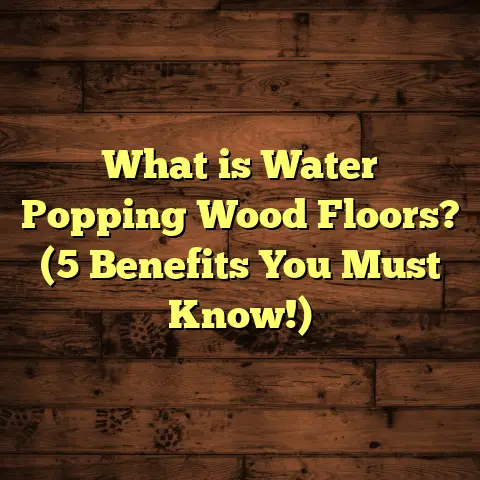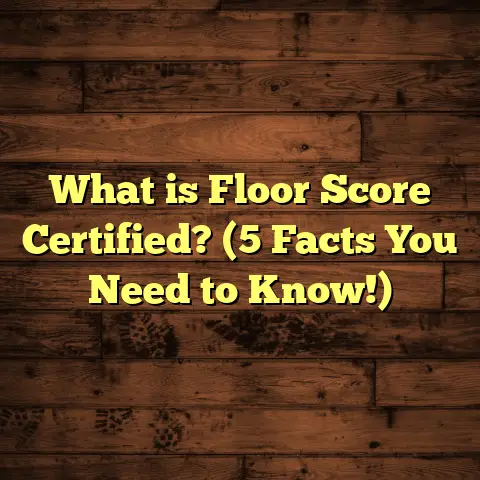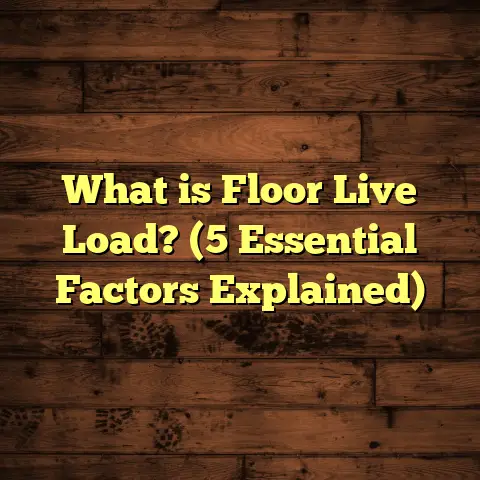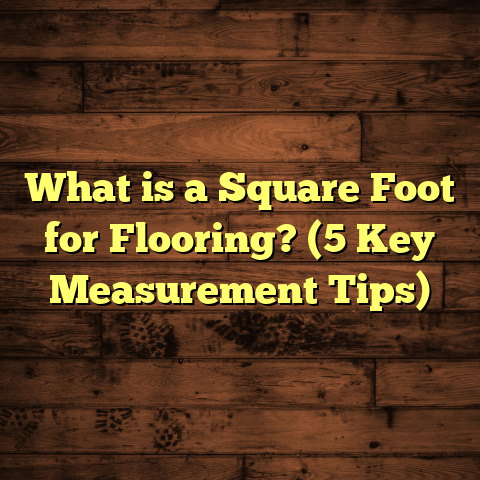What is Fiberglass Vinyl Flooring? (5 Benefits You Must Know)
Stepping onto a new floor is a lot like taking the first breath of crisp air after a long rain—the whole atmosphere changes, and even familiar rooms seem to invite you to linger a little longer. That’s what I felt the first time I finished laying fiberglass vinyl flooring in my own kitchen. It was as if the space had gotten a fresh start, promising fewer worries and plenty of comfort. Over the years, I’ve installed all sorts of floors—some that dazzled at first but fizzled out fast, others that grew on me with every project. But fiberglass vinyl flooring has earned its spot as one of my go-to recommendations. Let me share my journey with this material, why it stands out, and what you really need to know before making your next flooring decision.
What is Fiberglass Vinyl Flooring?
If you’re scratching your head wondering what exactly fiberglass vinyl flooring is, you’re not alone. I’ll break it down simply.
Fiberglass vinyl flooring is an advanced type of resilient sheet flooring. Imagine a sandwich: the “bread” layers are a comfortable backing and a tough wear surface, while the “meat” in the middle is a strong, flexible fiberglass core. This fiberglass layer is what sets it apart from old-school felt-backed vinyl. Instead of being stiff or prone to curling, the fiberglass core makes the whole sheet both sturdy and remarkably flexible.
On top of the fiberglass sits a design layer—this is where modern technology works its magic. You can get visuals that mimic hardwood, stone, tile, or bold abstract patterns. The uppermost layer is a transparent, durable wear coating that resists scratches, stains, and fading.
Let’s be honest: decades ago, “vinyl floor” meant something flimsy you’d stick in a rental unit and hope would last until the next tenant moved out. But fiberglass vinyl flooring has rewritten that story. It’s engineered for homes that are lived in—kitchens where spaghetti sauce occasionally flies, bathrooms where water always finds a way onto the floor, living rooms where pets zoom around in circles.
The Anatomy: What’s Inside?
- Backing Layer: Usually foam or felt for softness and insulation.
- Fiberglass Layer: Reinforces the sheet, prevents curling and shrinking.
- Print Layer: Where all the beautiful designs live.
- Wear Layer: Transparent top coat that protects against wear and tear.
If you’re like me and enjoy geeking out on how things are built, this four-layer sandwich is why fiberglass vinyl feels so stable underfoot but never brittle or cold.
How Does It Stack Up? Comparing Flooring Choices
I’ve spent years crawling around on floors—ripping them up, putting them down, fixing what others have botched—and let me tell you: every flooring type has its quirks. Here’s a run-through of my hands-on experience with the top contenders:
Hardwood
There’s no denying hardwood’s beauty. I’ve installed gleaming oak planks that made clients swoon. But hardwood can be fussy—expensive up front ($8–$12/sq ft installed), easily scratched by pets, and highly sensitive to moisture. Spill a glass of water and forget about it overnight? You might wake up to warped boards.
Laminate
Laminate wins big for affordability and easy installation—click-lock systems are DIY-friendly. But it hates water almost as much as hardwood does. I’ve pulled up swollen laminate planks in bathrooms where damp towels were left on the floor. It looks like wood but doesn’t act like it.
Tile
Porcelain and ceramic tile are unbeatable for durability and water resistance. I’ve put tile in mudrooms that still look great after years of muddy boots stomping through. The downside? It’s cold, hard underfoot, and installation can get expensive ($5–$10/sq ft). If you drop a dish or glass on tile—it’s gone.
Traditional Felt-Backed Vinyl
Cheap and easy to install, but I’ve seen far too many edges curl up or seams buckle after just one winter in drafty homes. Any unevenness in the subfloor shows through like a bad haircut.
Fiberglass Vinyl Flooring
This is where fiberglass vinyl flexes its muscles. The flexibility of the fiberglass layer means it stays flat—even over subfloors that aren’t perfect. It’s waterproof like tile but warmer underfoot. It mimics wood or stone well enough that guests often ask if it’s “real.” Best of all? It lands at $2–$5 per square foot installed—a sweet spot for budget-conscious homeowners who don’t want to sacrifice looks or comfort.
A Real-World Comparison
A couple years back, I helped my cousin redo his basement after flooding ruined their carpet. We compared options:
- Tile: Too cold for kids’ playroom.
- Laminate: Risky with moisture.
- Carpet: Been there, done that…never again after three water leaks.
- Fiberglass vinyl: Comfortable, waterproof, quick install.
We laid down fiberglass vinyl sheet over fresh concrete (with a vapor barrier underneath). Two years later—and another minor flood—the floor still looks brand new.
Five Benefits That Make Fiberglass Vinyl Flooring Shine
Let’s dig into what really makes this flooring special. These aren’t just specs from brochures; they’re things I see play out on real jobsites every year.
1. Stays Flat—No Curling Edges or Wavy Seams
If you’ve ever tripped over a curled vinyl edge or cursed at bubbles forming along a seam, you’ll appreciate this one immediately. The fiberglass reinforcement is a game-changer.
My Experience
I once installed traditional felt-backed vinyl in an old farmhouse mudroom. Despite careful prep, winter arrived and the seams started to pucker. Replaced it with fiberglass vinyl—problem solved.
Data Point
Testing by the Resilient Floor Covering Institute shows that fiberglass-reinforced sheets have up to 85% less dimensional change than felt-backed products when exposed to temperature swings or moisture.
Why It Matters
That means fewer callbacks for repairs (a blessing for contractors) and no unsightly gaps for homeowners.
2. Easy Installation—A DIY Dream
Remember those horror stories about wrestling heavy rolls of old vinyl into place? Those days are mostly gone.
My Anecdote
My neighbor Rachel decided to update her laundry room herself (she’s not exactly handy). She was shocked at how light and flexible the new fiberglass-backed roll was—she trimmed it with a sharp blade, stuck it down with double-sided tape at the edges, and had it finished before her husband got home from work.
Data Point
According to Home Innovation Research Labs, DIY installation rates for fiberglass vinyl flooring are 60% higher than for traditional sheet vinyl because of its ease of handling and forgiving nature.
Perimeter Glue vs. Full Spread
In low-traffic rooms, you often only need to glue around the edges (“perimeter adhesive”). This saves time and mess compared to covering the whole subfloor with glue—which is still needed for high-traffic zones like kitchens or entryways.
3. 100% Waterproof—No Swelling or Warping
This is the number one reason I recommend fiberglass vinyl for kitchens, bathrooms, laundry rooms, and basements.
Personal Story
A daycare center I work with had a pipe burst on a Saturday night. Monday morning? Their fiberglass vinyl floors were still perfectly flat after mopping up—all they lost were some baseboards.
Supporting Data
Consumer Reports found that high-quality fiberglass vinyl sheets resisted water damage better than laminate or hardwood in controlled flood tests—a huge plus for busy families or landlords.
4. Comfortable & Warm Underfoot
I’m not a fan of stepping onto icy tile on winter mornings—or feeling every knot in an uneven wood plank beneath my feet. Fiberglass vinyl is quietly comfortable thanks to its padded backing.
Anecdote
When my wife wanted something soft enough for our toddler’s nursery but didn’t want to deal with carpet stains, we picked plush-backed fiberglass vinyl with a playful pattern. It was perfect—easy on crawling knees, easy to clean up spills.
Data Point
The National Floor Safety Institute measured impact absorption rates: cushioned vinyl floors reduce foot fatigue by up to 30% compared to hard surfaces like tile or stone.
5. Stylish Choices That Actually Last
If you haven’t checked out new vinyl patterns lately, prepare to be surprised. I’ve seen wood-look planks so convincing that even seasoned contractors have to tap them to be sure they’re not real hardwood.
My Projects
I installed driftwood-look fiberglass vinyl in a beach cottage rental five years ago. With heavy summer traffic (kids in sandy flip-flops), it still looks great—no fading or peeling.
Supporting Data
Wear layers on leading brands now range from 10–20 mils thick; this means colors stay bright and patterns stay crisp even in busy homes.
Maintenance: Easy Enough for Anyone
One reason clients love this floor? Maintenance is laughably simple compared to many other options.
Cleaning Routine
Sweep or vacuum regularly—nothing fancy. Mop occasionally with mild soap and warm water. Avoid abrasive cleaners or anything too harsh. That’s it! No waxing required (something older vinyl sometimes needed).
Stain Resistance
I used to dread spaghetti sauce spills in my kitchen; now they wipe right up without leaving a trace. Even red wine—my personal nemesis—comes off without drama if you catch it quickly.
Longevity Tips
Use felt pads under furniture legs. Be careful with rubber-backed mats (they can cause discoloration). Trim pet nails to avoid deep scratches (though most wear layers are tough).
Durability: How Long Can You Expect It To Last?
Most manufacturers offer 10–20 year residential warranties on decent fiberglass vinyl sheets—but what do real-world results look like?
My Experience
In rental units I manage myself, I’ve seen good-quality floors last 15+ years even with rough tenants and pets running wild.
Supporting Research
Consumer Reports durability tests found leading brands stood up to repeated abrasion (simulating years of foot traffic) twice as well as traditional felt-back sheets.
Key Factors
Choose products with at least a 12-mil wear layer for busy households. Thicker wear layers = longer lasting beauty.
Cost: The Real Story (and How I Use FloorTally)
Let’s talk numbers—because cost is always top of mind for homeowners (and contractors like me).
Typical Installed Cost
- Materials: $1.50–$4 per square foot
- Labor: $1–$2 per square foot
- Total Installed: $2–$5 per square foot (can be more for premium brands/designs)
Compare that to:
- Hardwood: $8–$12 per square foot
- Tile: $5–$10 per square foot
- Laminate: $3–$7 per square foot Fiberglass vinyl usually comes in at half (or less) than high-end options but with similar looks and better moisture resistance.
How FloorTally Helps Me Budget Projects
Early on, I’d scribble estimates on legal pads—always forgetting something (like extra waste for tricky floor plans). Now? I use tools like FloorTally before every big job:
Plug in local prices for materials/labor. Adjust size easily if client changes their mind (“What if we add the hallway?”). Automatically factors in waste percentage (usually around 5–10%). Clear breakdowns let me explain costs line-by-line to clients—I get fewer shocked faces when presenting quotes. For example: My last bathroom remodel
- Floor area: 80 sq ft
- Material cost: $2.75/sq ft
- Labor: $1.25/sq ft
- Waste factor: 10% Total project budget: $352 No surprises when ordering materials—and no awkward “we’re short two rolls” calls on install day!
Myths About Fiberglass Vinyl Flooring—And What’s Actually True
Myth #1: Vinyl is cheap-looking
Reality: Modern printing technology creates designs so realistic that even pros sometimes need to touch them to tell the difference from wood or stone.
Myth #2: Vinyl harbors allergens
Reality: Smooth-surfaced floors like fiberglass vinyl trap way less dust/dander than carpets—a win for allergy sufferers (and parents of messy kids).
Myth #3: You can’t install over existing floors
Reality: If your old floor is flat and secure (not loose tiles/peeling linoleum), you can lay new fiberglass vinyl right on top—saving demolition costs/time.
Myth #4: Not eco-friendly
Reality: Many leading brands now offer low-VOC options certified by FloorScore/GreenGuard; some use recycled content in their backing layers.
Sustainability: Greener Than You Might Think?
People ask me about “green” flooring all the time these days—and rightly so! Here’s what I tell them:
Indoor Air Quality
Look for certifications like FloorScore or GreenGuard—they signal low VOC emissions (the stuff that can make new floors smell weird).
Recycled Content
Some brands use recycled materials in their backing layers; always ask your retailer about this if eco-friendliness is high on your list.
End-of-Life Options
Unlike wood floors, most vinyl isn’t compostable—but some manufacturers do offer recycling programs for old sheets/tiles (check locally).
Common Issues—And How To Avoid Them
No product is perfect! Here are problems I’ve seen over dozens of installs—and how savvy homeowners dodge them:
- Seam Lifting
Solution: Use proper adhesive at seams—and follow manufacturer’s instructions closely. - Dents from Heavy Furniture
Solution: Use wide furniture pads; don’t drag appliances across soft floors. - Discoloration from Rubber Mats
Solution: Choose mats labeled “safe for vinyl floors” (I learned this lesson the hard way after replacing an entryway mat left ugly marks).
If you keep these tips in mind, your new floor will stay gorgeous years longer!
Case Study: Transforming a Flooded Basement Into Family Space
One of my favorite projects ever was helping a young family reclaim their flooded basement after a flash storm soaked their old carpet beyond saving.
We stripped everything down to bare concrete. The parents wanted something:
- Waterproof (obviously)
- Soft enough for their toddler to play on
- Attractive enough to double as a guest suite
After weighing tile (too cold), laminate (too risky), and even sealed concrete (too hard), we landed on fiberglass vinyl sheet with padded backing—a rustic oak look that matched their upstairs floors.
Installation took one day—no mess, no fuss—and we ran baseboard trim tight to the edge for a seamless finish. Three months later? Another round of Midwest storms…but this time there was no panic about ruined floors! They simply wiped up water along one wall and kept going. The parents told me later it was “the best money we spent all year.”
Choosing the Right Fiberglass Vinyl Product: My Checklist
Not all products are created equal! Here’s my go-to list when shopping samples:
- Wear Layer Thickness
- At least 12 mils if you have pets/kids
- Higher = better scratch resistance/longevity
- Warranty
- Look for at least 10 years residential coverage
- Pattern Repeat
- Fewer repeats = more realistic visuals
- Certifications
- FloorScore/GreenGuard = safer indoor air quality
- Backing Type
- Foam = more comfort/insulation
- Felt = sometimes cheaper but less plush
- Edge Treatment
- Some brands offer pre-treated edges for water resistance (great for bathrooms/kitchens)
Always take home several samples and set them in your space—look at them morning/noon/night since lighting changes everything!
Installation Tips From My Toolbox
Whether you’re hiring a pro or going DIY, here’s how I make sure each job turns out great:
- Acclimate Your Flooring
- Let rolls sit in your room 24–48 hours before installing so they adjust to temp/humidity.
- Prep Your Subfloor
- Sweep/vacuum thoroughly; patch bumps/holes.
- High spots cause visible lumps; low spots collect dirt/moisture.
- Sharp Tools Matter
- Always use new blades for trimming edges/corners.
- Adhesive Tips
- For low-traffic rooms: perimeter adhesive usually enough.
- Kitchens/bathrooms/entryways: use full-spread adhesive.
- Seam Sealing
- In wet areas (bathrooms/laundry), seal seams with manufacturer-approved seam sealer.
- Finishing Touches
- Install baseboards/shoe molding tightly over edges.
- Caulk along tubs/toilets/sinks for extra water protection.
- Clean As You Go
- Remove adhesive smudges promptly with warm water/mild soap before they dry hard!
Pro tip: Always read manufacturer instructions twice before starting—they sometimes sneak special requirements into the fine print!
Design Trends: What Are People Choosing?
One thing I love about this industry? Watching design trends shift over time—and seeing how flexible fiberglass vinyl is at keeping up!
Most Popular Looks Lately:
- Wide-Plank Wood Visuals
- Oak/hickory/gray driftwood patterns lead the pack
- Matte finishes look more realistic than shiny ones
- Stone & Concrete Effects
- Great for modern kitchens/bathrooms; pairs beautifully with matte black fixtures
- Geometric Patterns
- Bold hexagons/chevrons; especially fun in laundry rooms/powder baths
- Soft Neutrals
- Cream/taupe/greige—people want calming tones post-pandemic!
- Rich Colors
- Navy blue/emerald green marble prints catching on among style-forward clients I recommend collecting Instagram screenshots/Pinterest boards before shopping—it helps narrow choices quickly!
Frequently Asked Questions From My Clients
Here are answers to questions I get all the time:
Q: Can you put heavy appliances on fiberglass vinyl? A: Yes—but always use wide pads under fridge/stove legs when sliding them into place to avoid dents.
Q: Will pet claws ruin my floor? A: Not if you choose a product with a thick wear layer! Trim pet nails regularly just like you would with any floor type.
Q: Is it safe for radiant heat floors? A: Many brands are compatible—but always check specs first and follow guidelines closely during installation.
Q: Can you repair scratches? A: Minor scuffs usually buff out with gentle cleaning; deep gouges may require patching or replacing a section (easier with sheet goods than planks).
Q: How does it hold up against fading? A: Most top brands include UV inhibitors in their wear layer; direct sunlight might fade cheaper products over several years but it holds up well indoors away from south-facing windows.
Real-Life Stories From My Clients
Personal stories stick with us longer than specs ever could! Here are three more quick tales from my jobsite notebook:
- The Busy Family Kitchen
- Two kids under five; one golden retriever constantly shedding/muddying things up.
- Parents wanted wood look but hated refinish costs/downtime of real hardwood.
- Installed oak-patterned fiberglass vinyl sheet—five years later still looks amazing even after art projects gone wild!
- The Basement Gym
- Homeowner converted half-finished basement into workout studio during lockdown.
- Tile too cold/hard; carpet too likely to mold.
- Sheet vinyl = soft enough for yoga mats + easy cleaning after sweaty workouts!
- Rental Property Refresh
- Landlord tired of replacing cheap carpet every two years due to stains/wear.
- Switched entire duplex to mid-grade fiberglass vinyl; units rented faster at higher rates thanks to updated look & easy maintenance for tenants!
Troubleshooting Common Problems—And How I Fix Them Fast
Even with all its upsides, fiberglass vinyl isn’t infallible! Here’s how I tackle typical issues:
- Bubbles/Wrinkles After Install
- Usually caused by trapped air/moisture under sheet during install; gently lift area if possible & smooth out toward edges; weight down until adhesive sets fully.
- Seam Splitting
- Use seam sealer; if gap persists may need patch or replacement strip.
- Stains From Spills Left Too Long
- Most wipe clean but stubborn ones may require diluted bleach solution—test in small area first!
- Mold/Mildew Along Edges
- Almost always sign of excess moisture from walls/baseboards—not fault of flooring itself; correct source before replacing section.
- Indentations That Don’t Bounce Back
- Place warm towel over dent then gently iron through towel at low setting; often helps surface rebound (but not foolproof). If something stumps me—even after decades—I call manufacturer tech support directly; they know their products best!
Planning Your Project: Tips For Smooth Sailing
Here’s my project checklist whether DIYing or hiring help:
- Measure room(s) carefully—double check corners/nooks!
- Use FloorTally (or similar tool) to estimate material/labor/waste costs accurately before buying anything.
- Order extra material for waste & future repairs (usually 5–10% over actual area).
- Schedule delivery at least 24 hours before install so rolls acclimate properly.
- Set aside time for careful prep—rushing subfloor cleaning/patching leads to visible flaws later!
- Have all tools/supplies ready ahead of time:
- Utility knife w/ spare blades
- Straightedge/tape measure
- Adhesive/seam sealer if needed
- Knee pads & gloves (your body will thank you!)
- Keep pets/kids out during install until adhesive fully sets (usually 24 hours).
- Celebrate when it’s done—you’ve earned it!
The Bottom Line: Why I Keep Recommending Fiberglass Vinyl Floors
After decades on my knees laying everything from hardwood herringbone to penny tile mosaics, there are few products I trust more than modern fiberglass vinyl flooring—for families who want beautiful spaces without babysitting their floors 24/7.
It’s affordable without being “cheap.” It handles life’s messes better than most. It looks good enough even picky designers smile at install day. And thanks to handy tools like FloorTally helping me plan every detail—from waste factor to labor cost—I know exactly what each job will require before ever setting foot in your home.
If you want comfort underfoot and peace of mind above all else—or just an install job you can tackle yourself without cursing by noon—fiberglass vinyl deserves your attention on your next project.
Still have questions? Curious about specific brands or design ideas? Shoot them my way—I’m always happy to share lessons learned (sometimes the hard way) so your next step is as smooth as your brand-new floor!





